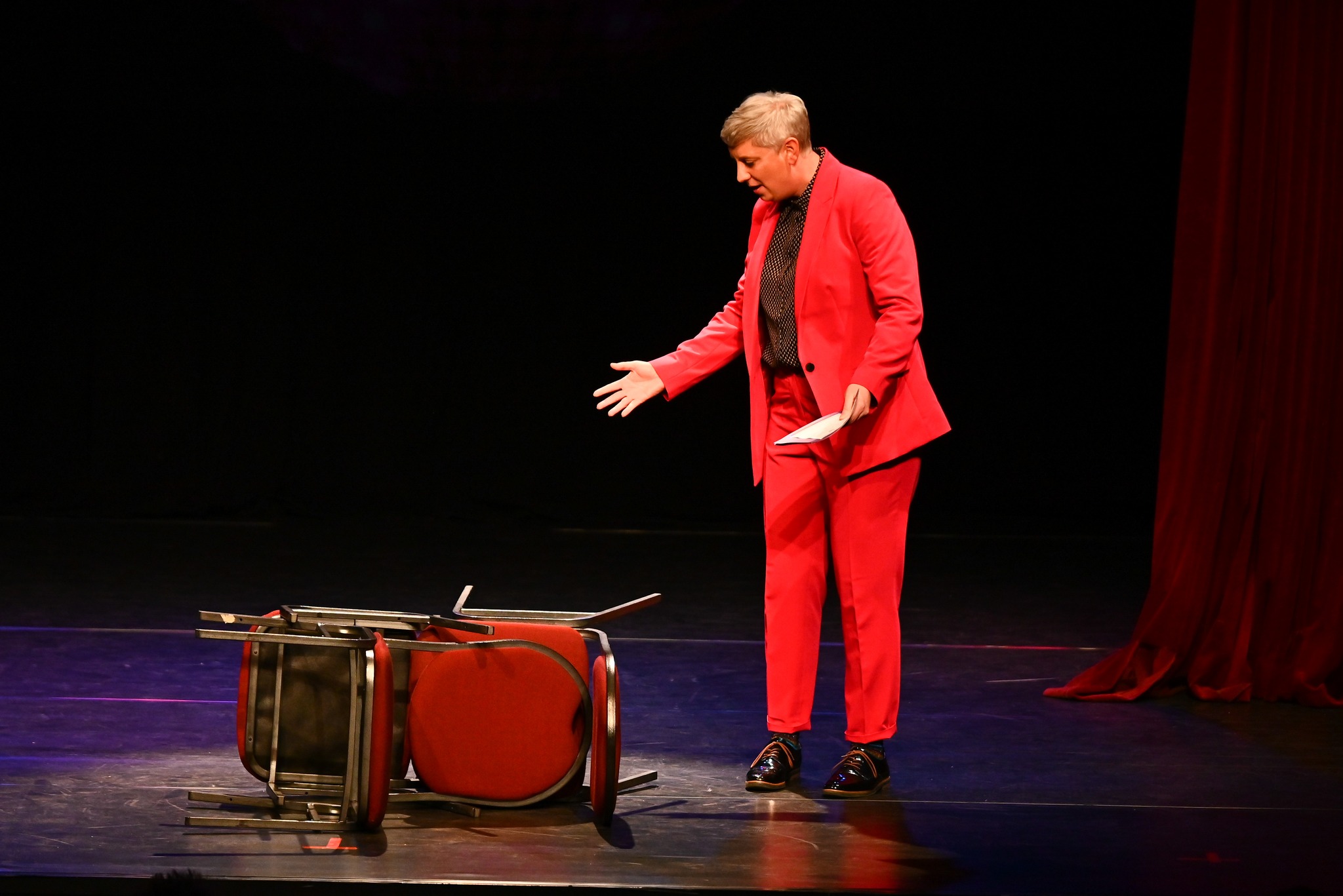THOUGHTS, IDEAS, QUESTIONS, PROCESS, LESSONS,
Student Post
Healthy Stress!
Cindy Pittens – Week 4
Week 4 at the Improvisation school.
Title: Healthy stress!
This week was about conquering my biggest fear. The fear of being refused. A fear that, of course, has its roots in my childhood and, as for many people, is causing all kinds of coping behaviour –
Behaviour of control and protection against the posibility of being refused in your essence.
Improvising is scary
As an improviser, we struggle with this on stage, because first of all, we are following our impulses, which is very vulnerable. You let people see the worst and the best of you.
There also is instant feedback from the audience. The 60+ pair of eyes that stare in your face (that our primal brain interprets as danger). An audience with expectations and the wish to be entertained.
Flee, freeze, fight or improvise freely
What happens often, is that we disconnect, in moments of threat. We flee, freeze or fight, which of course are not states, in which we can improvise freely. Flow and creativity are shut down. The inner critic is rampant. We don’t seek eye contact. We ignore offers, because of the overload in our brain. You can’t think clearly anymore. We don’t even try to relax, because your brain is telling you to be cautious and ready to save yourself.
Off my feet
Something interesting happens to me, here in Canada, in class. I feel so much more insecure than at home. Normally I do my job. I teach, play, and facilitate workshops and team building. I know what I am doing and rely on my knowledge and on the positive feedback I get. Here, somehow I am thrown off my feet. I think part of the reason for this, is travelling to another country. The other language, figuring out your social skills again in a new environment and no old routines to rest in.
Coping
But something else is happening as well. We are in a small class of 5, which is intimate. No place to hide, always in sight. And we have a teacher who is well equipped to look right through all the well-established coping mechanisms. The ones that keep me on my feet.
To behave happy, when I am not, and disengage from my own feelings. Which is very tiring. And it keeps me from connecting with others as well. Or the opposite: to talk about every hiccup, so we can verbally create a controlled social environment. Which again, is very tiring and takes out all of the lightheartedness in the room.
Both don’t work well on stage as well.
Just as scared, but hidden better
So, I say, that I think I don’t feel insecure at home. But I actually came to Canada to find a way to improvise more fluently and relax. So probably I feel just as threatened, but there is no one to call out the coping mechanisms that keep me ‘safe’. And that is exactly what is happening here. I am confronted with how my coping does not work well on stage.
Exercise
So in class, we exercise our brain to find a state that copes with this possibility of refusal and threat and is helpful in improvisation. How does that work then?
Improv is not therapy, right? Right.
So we have clever exercises (thank you Keith Johnstone) that teach you how to improvise and wipe you off your controlled feet. I will talk about one of them to give you an idea, how this works.
STORYTELLING – COLOR – STORY – EMOTION
Healthy Stress!
We practiced storytelling. 6 people in class. Stand solo for the group (audience) and tell a story. The audience is asked to shout what they think the story needs. Color, Emotion or story. The audience is 100% responsible for the story.
COLOR
Think of all you can see, hear, smell, touch and feel and taste. “On his skin, we saw pearls of sweat and his t-shirt had brownish-yellow stains. Dust swirled around the dark mine”.
EMOTION
This is about the emotional interpretation of the story. You can do that with words. “She felt ashamed and didn’t want anything other than to disappear”. Or by expressing the emotions with body and tone of voice.
STORY
If you think the story needs steps forward. In Holland we would call this part Action.
Do it!
Storytelling is my weak point. But I’d like to learn it. I’m going 1st. A not-very-interesting story emerges. An inner critic in my head is telling me, what a bad storyteller I am.
The audience hardly called out anything.
Logically. It’s the first round for practice. Does not matter.
Next rounds, the audience was made clear that they have to help the storyteller out! Be honest in your feedback!
When the audience didn’t help me out, I felt left alone. With my inner critic. The audience indeed, was a ‘silent threatening group’ that stared in my direction and did not interact with me. Fear was triggered.
Duo’s
The same assignment again but in pairs.
Since I was scared, I gave myself some air, to be able to do the exercise. I told a real anecdote, instead of making one up. I could now focus on emotions, story and colour. So although this was a healthy decision for me, I felt like a cheat. And my inner critic grew bigger.
On the other hand, I could slightly sense, that it was helpful that my partner gave me direction. So by giving me the directions, I felt as if I was supported.
Instant feedback
Same assignment again, but now the audience offers physical instead of verbal feedback.
For more emotion, walk to the left. For more colour, walk to the right. When you’re happy with how the story is told, you squat down. If you want more story, you take a step towards the narrator.
What?!
A group of people who come towards you because they think your story should be better!?
Physical, mass disapproval of what you are doing! And that is called ‘healthy stress’.
“It’s like on stage!”, Shawn says.
I couldn’t think anymore – had a blurry brain – and I was completely panicking.
YOU CAN’T DO THIS TO PEOPLE, CAN YOU?
Paul the hero!
Paul went the first time. I didn’t even dare to participate in my audience role and remained glued to my seat. I was curious as to what would happen though. Shawn knows what he’s doing, right?
Paul continued to deal with the assignment in a playful way, in addition to the fact that the tension was also rising for him. I thought: “Oh… you actually cán do that…”
I could feel myself land… a little. A little less overwhelmed, so I at least could think again.
Again
I asked Shawn to explain the assignment again. It was my fear, seeking certainty. I understood the rules. But it didn’t feel that way. At that moment my head was full of grit and I sought certainty. Next time, I know now, maybe I won’t have to ask for more instructions.
Stay Playful
The second player went, the third, and with every player who could handle it well, my confidence grew a little bit. Until someone was so good that my fear of failure rose again. Luckily there was one more person ahead of me. And he made a mess of it in his wonderful clownish way. I started to understand again, how to playfully deal with failure.
Thank you, class – for showing me!
Come on then!
Until then I had always soothed myself with: “If you don’t want to, you don’t have to go.”
With every follow-up: “But if you want to, you have to go.” So at the very last minute, I plucked up the courage and went too. I started with something real about myself and later that story turned into something made up. Just a little more risk, than in the pair setup, but still comfortable enough to take part in the exercise.
Of course, it was never as scary as it seemed beforehand. I just told a story, as I have many times. Especially in hindsight, I could consider what happened. I realized that I felt alternately threatened and supported by the audience that came towards me. The hints don’t just feel like disapproval. It was also support.
How did that work?
We kept eye contact. One was 100% involved in my process and the story I wanted to tell. You could read that on their faces. Sitting down was always a confirmation that I was on the right track. And the other movements also meant something constructive and gave me direction
The moral of the story of last week is: “You are only brave if you know fear”.
What I want to say with that, is that this class and the teacher, and me as well, are keeping me at the perfect spot, in touch with my fear. This helps me into new ways of dealing with feeling threatened and hopefully be brave enough to get rid of old behaviour that keeps me away from connection and creativity.
If you want to read more about my experiences. I write a daily blog here: facebook.com/cpimpro




0 Comments